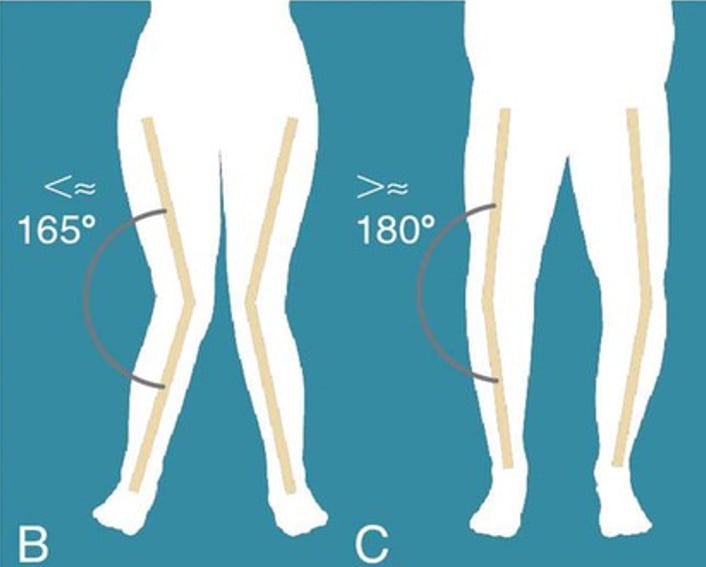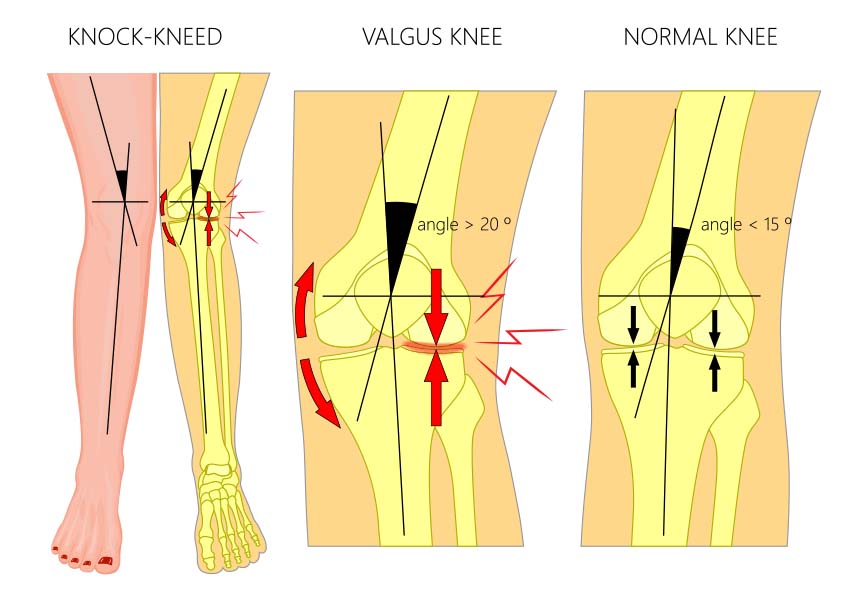Genu valgum or knock knees
Genu valgum occurs when the distance between the medial malleoli in a standing patient is greater than the distance between the knee joints. In genu valgum, the lateral side of the knee joint is subjected to greater forces than the medial side, resulting in tension in the medial ligaments and compression of the lateral surfaces.
Excessive genu valgum occurs when the lateral angle at the knee joint is less than 165° (Figure 1B).
Newborns and infants have moderate genu varum . In the first months of life, the infant’s limbs grow faster than the head and body, and gravity also has an effect on the development of body segments. Therefore, at around eight or nine months of age, when infants begin to pull themselves up to a standing position, their knees exhibit genu varum in the frontal plane (1).
Normally, physiologic genu varum improves gradually as the child begins to stand and walk. At around 18 months of age, correction to normal alignment is complete. During the second to fourth year of life, children MAY develop genu valgum.
At the age of three, about 75-80% of children have mild genu valgum (an intermalleolar distance of 2-5 cm measured with the child standing erect using a measuring tape). The condition then gradually improves and by the age of six or seven, normal alignment of the lower limbs develops (1, 2, 3).
Pathologic genu valgum often requires medical intervention (4). An excessive angle (>10°) that persists beyond eight years of age may cause the child pain (in the knee, thigh or lower leg) and discomfort when walking due to friction between the medial surfaces of the knees (5, 6).
In the long term, persistence of knee misalignment may increase the risk of developing or exacerbating osteoarthritis of the knee (7, 8).
Diagnosis of genu valgum in children
Genu valgum is a clinical diagnosis. Patients with this condition are typically asymptomatic but may present with medial-sided knee and ankle pain (16). Intermalleolar distance is used to assess the degree of genu valgum.It is the distance between the medial malleoli in a standing patient with touching medial femoral condyles. An intermalleolar distance of 5 cm or more suggests physiologic genu valgum (17).
Coronal plane angulation of the lower extremities can be analysed based on the deviation of the centre of the knee from the mechanical axis and the tibiofemoral angle (TFA). The mechanical axis is a line connecting the centre of the femoral head to the centre of the ankle. In normal coronal alignment, the mechanical axis passes through the centre of the knee.
There is lateral and medial deviation with respect to the mechanical axis in genu varus and genu valgum, respectively (Patel and Nelson 2020). TFA is a reliable tool for determining genu valgum and genu varum deformities in subjects and the result is not influenced by the observer. TFA is the angle between the anatomical axis of the femur and the anatomical axis of the tibia.
Radiographs are not indicated in children with physiologic genu valgum. However, they are used in the setting of asymmetrical findings or clinically excessive genu valgum in an age group where physiologic genu valgum should have been resolved (Patel and Nelson 2020).
Treatment of genu valgum
Conservative treatment
It is generally believed that physiologic genu valgum in children under the age of seven resolves without treatment (10, 5, 9, 3). Treatment is necessary when genu valgum worsens and causes pain or discomfort (5). In this case, conservative treatment should be considered first.
A review of available literature shows that various techniques are used today to affect joints and muscles. The effect of kinesiology tape on the neuromusculoskeletal system has been extensively studied (11, 12, 13, 14, 15). and is described as a mechanical correction technique used to affect a muscle, fascia or joint, as a result of which the body adapts to the stimulus to achieve the desired correction. A disadvantage of kinesiotaping is the short-term effectiveness of one strip – elastic polymers start to weaken after three to five days.
Surgery
The main goal of surgical treatment of pathologic genu valgum is to restore the correct alignment of the joint. Various techniques which affect bone growth are used to correct the condition, including partial epiphysiodesis, hemiepiphyseal stapling or osteotomy (4).
As existing approaches are either invasive or require specialist intervention, there is a need for a simpler and more readily available method of correction. Since 2012, researchers from the University of Tartu and specialists from Tartu Health Care College have been engaged in the development and testing of GV Correct, a garment with pressure applicators, to correct genu valgum in children.
Prevalence of genu valgum in children
According to research, 2-14.5% of primary school children aged 7-14 years have genu valgum (18, 19, 20, 21).
It has been observed that obesity can significantly affect the incidence and likelihood of genu valgum (22, 23, 24).
References
- Stout, J. L. (2006). Gait: Development and Analysis. Raamatus: Campbell, S. K., Vander Linden D. W., Palisano, R. J. (Ed.-s.). Physical Threapy for Children 3th ed. St.Louis: Saunders Elsevier.
- Kendall, F. P., McCreary, E. K., Provance, P. G., Rodgers, M. M., Romani, W. A. (2005). Muscles testing and function with posture and pain. 5th ed. Philadelphia: Lippincott Williams & Wilkins.
- Jesse, M. W., Leach, J. (2012). Orthopedic Conditions. Raamatus: Campbell, S. K., Palisano, R. J., Orlin, M. N. (Ed.-s.). Physical Threapy for Children 4th ed. St. Louis.: Elsevier Saunders.
- White, G., R., Menico, G., A. (1995). Genu Valgum in Children: Diagnostic and Therapeutic Alternatives. Journal of the American Academy of Orthopaedic Surgeons, 3: 275 – 283.
- Espandar, R., MD, Mortazavi, S.M-J., Taghi, B. (2010). Angular Deformities of the Lower Limb in Children. Asian J Sports Med. 2010 Mar; 1(1): 46–53.
- Guzman, H., Yaszay, B., Scott, V. P., Bastrom, T. P., Mubarak, S. J. (2011). Early experience with medial femoral tension band plating in idiopathic genu valgum. Journal of Children’s Orthopaedics, 5(1): 11–17. doi:10.1007/s11832-010-0310-6
- Sharma, L. (2007). The Role of Varus and Valgus Alignment in Knee Osteoarthritis. Arthritis & Rheumatism, 56(4): 1044 – 1047. doi: 10.1002/art.22514
- Sharma, L., Chimel, J. S., Almagor, O., Felson, D., Guermazi, A., Roemer, F., Lewis, C. E., Segal, N., Torner, J., Derek, T., Cooke, V., Hietaps, J., Lynch, J., Nevitt, M. (2013). The Role of Varus and Valgus Alignment in the Initial Development of Knee Cartilage Damage by MRI: the MOST Study. Annals of the Rheumatic Diseases, 72(2): 235 – 40. doi:10.1136/annrheumdis-2011-201070
- Fabry, G. (2010). Clinical practice. Static, axial, and rotational deformities of the lower extremities in children. European Journal of Pediatrics, 169(5):529-34. doi:10.1007/s00431-009-1122-x
- Sass, P., Hassan, G. (2003). Lower extremity abnormalities in children. Am Fam Physician. 2003 Aug 1;68(3):461-8.
- Lin, J., J., Hung, C., J., Yang, P., L. (2011). The effects of scapular taping on electromyographic muscle activity and proprioception feedback in healthy shoulders. Journal of Orthopaedic Research, 29(1):53-7. doi:10.1002/jor.21146
- An, H. M., Miller, C., McElveen, M., Lynch, J. (2012). The Effect of Kinesio Tape® on Lower Extremity Functional Movement ScreenTM Scores. International Journal of Exercise Science, 5(3) : 196-204. http://rocktape.net/downloads/ktandfmsstudy.pdf (31.03.2015)
- Choi, Y. K., Nam, C. W., Lee, J. H., Park, Y. H. (2013). The Effects of Taping Prior to PNF Treatment on Lower Extremity Proprioception of Hemiplegic Patients. Journal of Physical Therapy Science, 25(9): 1119–1122. doi:10.1589/jpts.25.1119
- Tamburella, F., Scivoletto, G., Molinari, M. (2014). Somatosensory inputs by application of KinesioTaping: effects on spasticity, balance, and gait in chronic spinal cord injury. Frontiers in Human Neuroscience, 8: 367. doi:10.3389/fnhum.2014.00367
- Kase, K., Wallis, J., Kase, T. (2003). Clinical Therapeutic Applications of the Kinesio Taping Method. 2nd ed. Japan: Ken Ikai Co. Ltd.
- Patel, M., Nelson, R. (2020). Genu valgum. https://www.ncbi.nlm.nih.gov/books/NBK559244/
- Viigand, K., Utsal, Ü. (2012). O- ja X-jalad. https://www.kliinikum.ee/wp-content/uploads/2019/12/o_ja_x_jalad.pdf
- Maria Célia Cunha Ciaccia,Camila Nazareth Pinto,Fernanda da Costa Golfieri,Tales Ferreira Machado,Lívia Lopes Lozano,João Marcel Sanseverino Silva,and Vera Esteves Vagnozzi Rullo (2017). Prevalence Of Genu Valgum In Public Elementary Schools In The City Of Santos (Sp), Brazil https://www.ncbi.nlm.nih.gov/pmc/articles/PMC5737256/#B12PREVALENCE OF GENU VALGUM IN PUBLIC ELEMENTARY SCHOOLS IN THE CITY OF SANTOS (SP), BRAZIL[i]
- Karimi-Mobarake Mahmoud, Kashefipour Alireza, Yousfnejad Zahra (2005). The Prevalence of Genu Varum and Genu Valgum in Primary School Children in Iran 2003-2004 https://www.researchgate.net/publication/26562326_The_Prevalence_of_Genu_Varum_and_Genu_Valgum_in_Primary_School_Children_in_Iran_2003-2004
- Michał Brzeziński, Zbigniew Czubek, Aleksandra Niedzielska, Marek Jankowski, Tomasz Kobus, Zbigniew Ossowski (2019). Relationship Between Lower-Extremity Defects And Body Mass Among Polish Children: A Cross-Sectional Study https://pubmed.ncbi.nlm.nih.gov/30777046/
- Martina Bell Jiménez Aparicio, Jaime José Gutiérrez Gomez, Eloy Bernal Diaz, Adriana Jocelyn Montero Pascasio (2018). Prevalencia De Deformaciones Óseas En Extremidades Inferiores En Niños De 2 A 14 Años Residentes De La Comunidad El Jobo, Tuxtla Gutiérrez, Chiapas, México http://scholar.googleusercontent.com/scholar?q=cache:8t9NseHhG84J:scholar.google.com/&hl=en&as_sdt=0,5
- V. R. S. Putri, N. W. Tianing, A. W. Indrayani, A. Wibawa, and S. A. P. Thanaya (2020). Prevalence of Genu Valgum in Children Aged 10-12 Years with Excessive Body Weight (Overweight/Obesity) in Sanur Kaja Village, Denpasar https://ejournal2.undip.ac.id/index.php/jekk/article/view/7727
- B Bonet Serra, A Quintanar Rioja, M Alavés Buforn, J Martínez Orgado, M Espino Hernández, F J Pérez-Lescure Picarzo (2003). Presence of genu valgum in obese children: cause or effect? https://pubmed.ncbi.nlm.nih.gov/12628094/
- Agnieszka Jankowicz-Szymanska, Edyta Mikolajczyk (2016). Genu Valgum and Flat Feet in Children With Healthy and Excessive Body Weight https://pubmed.ncbi.nlm.nih.gov/26914720/



